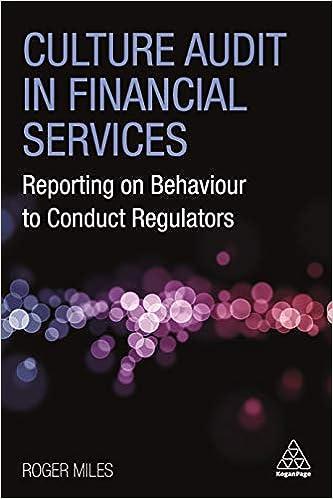Answered step by step
Verified Expert Solution
Question
1 Approved Answer
From the last lesson we see the Balance Sheet prepared at the end of the month contains ALE Assets = Liabilities + Equity. A=L+E The
From the last lesson we see the Balance Sheet prepared at the end of the month contains ALE
Assets = Liabilities + Equity. A=L+E
The Income Statement will report how much $ the business made/lost for the month...Net Income/.
The first 5 chapters are dealing with a Service Business we either charge our customers by the hour or a flat fee. Every time work is done the business is worth more. If we do a $80 job we will collect & our CASH Asset goes up (A=L+E)...CASH goes up EQUITY (worth of the Business) goes up....If we do not collect immediately then ACCOUNT RECEIVABLE Asset goes up & EQUITY goes up. Depending upon the type of business; the work may be called SERVICE REVENUE or FEES EARNED or RENT REVENUE or INTEREST INCOME.
EXPENSES are defined as anything you use to operate the business each month....Rent, Electric, Etc. Every time you have an Expense the business is worth less as your CASH Asset goes down & to maintain A=L+E the EQUITY must go down.
Please turn to Page 20....4 Financial Statements are shown...So far we have talked about the Balance Sheet & the Income Statement....We will deal with the Equity Statement in Chapter 4.. The Cash Flow Statement is a chapter in the next course.
All the $ amounts that we see listed on the statements came from a book called the GENERAL LEDGER....This book is in Chapter 2...Each page of this book is called a ACCOUNT... If we imagine the pages of the book in alphabetic order we would find:
Accounts Payable
Accounts Receivable
Building
Cash
Equipment
Fees Earned
Land
OwnerDrawing
OwnerEquity
Rent Revenue
Supplies
Utilities Expense
Wages Expense
If you were handed this book at the end of the month you would copy the total of each page onto either the Income Statement or the Balance Sheet..NOTE: The only page you would not use is the OWNERS-Drawing page ( It will appear on the Equity Statement)... How each page has a $ total is in Chapter 2. What the student needs to know at this point is what goes on the Income Statement & what goes on the Balance Sheet.
Please note that the transactions listed in the chapter are to prove A=L+E...Meaning that no matter what happened the ASSETS will always = LIABILITIES + EQUITY....The column set up of the exhibit confuses many students....To repeat all you need to know at this point ---When you see an ACCOUNT name---on which statement does it go & where...
4 POINT QUESTION TOWARDS FINAL GRADE :
Above is a list of 13 ACCOUNTS-------Accounts Payable thru Wages Expense----If the total of each ACCOUNT is $5,000 what will be the NET INCOME ?
this was the previous lesson
LESSON #2
The introduction said that if you are the owner of a business; the Accountant will hand you 2 Financial Statements at the end of each month..The Income Statement shows how much you made or lost for the month.. If + we call it NET INCOME if a - we call it NET LOSS.
The Balance Sheet shows how much your business is worth at the end of the month. (NOTE: this course deals with sole proprietorship = 1 owner, Partnerships & Corporations are in the next course).
You meet someone who is a millionaire , that means this person is worth a million $. We take everything the person OWNS and make a $ list ( house, car, jewelry, clothes, electronics, $ in the bank, etc.). From this total we subtract all debts ( mortgage, auto loan, credit cards, etc.)...If the answer is greater than $1,000,000 then the individual is a millionaire.
OWN - OWE = WORTH
Now to the Accounting terminology:
OWN = ASSET
OWE = LIABILITY WORTH = OWNER EQUITY
ASSETS - LIABILITIES = OWNERS EQUITY
The Balance Sheet at the end of the month will list every Asset & Liability of the business.. The reason it is called a Balance Sheet is due to the format...The Assets are listed on the left while the Liabilities & Owner Equity are listed on the right...we then see:
TOTAL ASSETS = TOTAL LIABILITIES + OWNERS EQUITY
Asset examples :
CASH .........refers to $ in the bank ( the text does not deal with coins & currency until Chapter
8everything is done by check) EQUIPMENT
LAND
BUILDING
SUPPLIES
ACCOUNT RECEIVABLE......this is the amount of $ that your customers owe you...this is an
Asset because you can legally sell it (like land) to another Business.
Liabilities :
ACCOUNTS PAYABLE.....you owe but no interest is being added...( Your August gas bill is due
September 15)
NOTES PAYABLE, LOANS PAYABLE ........these have interest added & are dealt with later
Step by Step Solution
There are 3 Steps involved in it
Step: 1

Get Instant Access to Expert-Tailored Solutions
See step-by-step solutions with expert insights and AI powered tools for academic success
Step: 2

Step: 3

Ace Your Homework with AI
Get the answers you need in no time with our AI-driven, step-by-step assistance
Get Started


